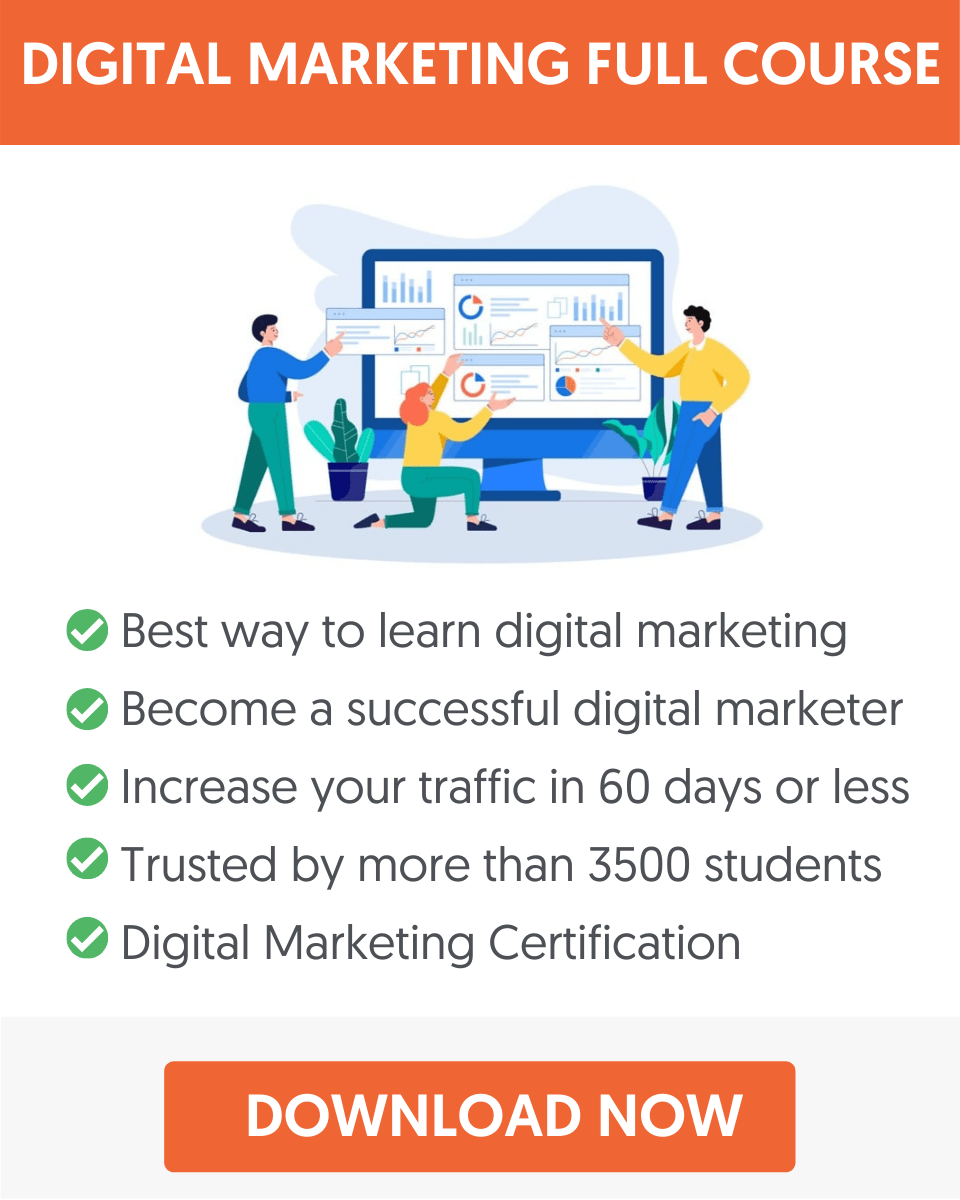What are Lead Magnets and How to Use Them (With Examples)
Businesses need to nurture their prospects before they become customers.
This is why it is critical for companies across industries to build an email list.
With a prospect’s email, you have a direct communication channel that you can use to provide value while selling them the benefits of your products or services.
But how do you build a list of people interested in your business?
The answer is lead magnets.
In this guide, I’ll explain what lead magnets are and how you can use them. I’ll also show you some examples of successful lead magnets including one of our own.
What is a Lead Magnet?
A lead magnet is a tool used by businesses to gain a prospect’s contact information. It is usually some type of resource that is given away for free in exchange for the person’s email address.
Sometimes, the business will ask for more information such as a name, phone number, or company.
Lead magnets come in a wide variety of forms including eBooks, templates, and webinars, among others.
How to Use Lead Magnets in Marketing
Lead magnets have a clear objective. Gather contact information from people in your target audience.
The process of using them for marketing can be broken into a few simple steps.
- You create a resource that addresses a particular problem area your audience faces.
- You add the lead magnet to different places on your site.
- You drive traffic to the lead magnet.
- As people sign up, you begin to move them through your digital marketing funnel towards your business objectives.
Lead magnets have practical use cases across a wide range of industries.
Here are some examples of how different types of companies can use lead magnets
- A software as a service (SaaS) company can use them to find the features a particular person needs.
- A business services company can use them to find people their sales team can contact.
- A blog owner can use them to gain subscribers to which they can email affiliate offers.
- An e-commerce store can use them to send subscribers promotions and new releases.
The best resource to use for your lead magnet and what information you ask for will vary based on your business.
Some companies require more information than others as they need to qualify their leads.
Qualifying leads is the process of verifying that the prospect fits the traits of your target customer and will actually use the solution you provide.
This is more common among companies with higher-priced products/services.
For example, if you sell a software solution that is intended for enterprise organizations, it is beneficial to know if a lead works for a large company.
In this situation, you can add additional fields to your sign-up forms such as company name, company size, and position.
By adding these fields you’ll know right away if someone meets your desired qualifications.
This can save the wasted effort of reaching out to someone who isn’t a viable target.
How to present lead magnets
The offer for the lead magnet is presented with a signup form that is used to capture people’s information. Businesses tend to present their lead magnets in a specific way:
- Landing page: Lead magnets are often presented on a web page dedicated to just the lead magnet. The standard procedure is to include a heading, a bit of copy, a sign-up form underneath, and a picture to the side.
- Thank you page: After the user enters their information, they are taken to a thank you page that acknowledges their submission. Some thank you pages will contain a direct link to download the resource.
- A follow-up email: Upon giving their information, users often receive a follow-up email. The email generally thanks the user for signing up and contains a link to access the lead magnet.
You can also present lead magnets using forms embedded throughout your site. This could be a popup, a form in the sidebar of your blog, sign-up fields in your footer, or a modal slide-in.
These forms can contain the sign-up fields so that users can subscribe without leaving the page, or they can contain a call to action (CTA) button that takes users to the dedicated landing page.
What makes a good lead magnet?
Here are some of the key elements of a good lead magnet:
Specific focus
If your lead magnet is vague it will unlikely gain the interest of your target audience. As such, lead magnets should provide a specific solution for a specific problem.
For example, a detailed guide on how to start a website is more useful than a video explaining the history of content marketing.
If your business offers solutions in more than one area, you can always create multiple lead magnets. These lead magnets will perform better as they are more relevant to the solutions you provide.
High perceived value
Lead magnets must seem highly valuable to your audience. Otherwise there isn’t a reason for them to give you their contact information.
If you are giving away something that your audience thinks is valuable for free, you have a good chance to see high conversions.
Satisfy a customer pain point
Your lead magnet should directly address your audience’s problems.
They should know right away that your business is a potential solution to solving their pain points.
Unique value proposition
Lead magnets should present the unique offering your business brings and should convince customers that you are a better solution to their problems than your competitors.
Fast consumption
Your lead magnets will be more valuable if your audience can consume them faster.
An eBook with hundreds of pages may provide some useful insights but will your audience have time to read it all?
Your prospects understand this and will be more likely to grab a lead magnet they will actually use.
Best Types of Lead Magnets
There is no limit to what types of materials you can use as a lead magnet. As long as your customers find it valuable, it can serve as an effective tool for building your email list.
That said, some types of lead magnets have proven to work better than others.
Let’s examine some of the most common forms of lead magnets:
eBooks
eBooks are a popular form of a lead magnet as they let businesses give their audience detailed guidance on a specific subject.
They typically come in the form of a PDF which can be accessed directly via a web browser or a link in an email.
What’s great about eBooks is that they are easy to create. You can start with some of your existing content, repurpose it, and then some additional material.
It’s important not to make your eBook too long for the reasons mentioned earlier.
Here are some great examples of free SEO eBooks used as lead magnets by different companies.
Trials and demos
Free trials and demos grant users temporary access to a product or service. Obviously, you can only use these for something that users need to access on a consistent basis such as a software solution or a membership site.
Free trials are essential to software products. Businesses and individuals usually need software to solve a particular use case. There is no way to really know if a solution will fit the bill until you’ve tried it out.
You combine this with the higher prices that often accompany software products (particularly those with a one-time fee), free trials become an invaluable way to win customers.
Case studies
Case studies are detailed, written stories about how your business helped a previous customer.
They are a great type of lead magnet as they give your audience a real-world example of the value your business provides.
If you have a good success story from a previous customer, you can write up a report on their experience. It should detail what the client needed to achieve and how you helped them do so.
It’s important to include specific performance metrics showing the results you were able to achieve.
Discounts
Everyone loves saving money. Whether you’re an e-commerce store or a SaaS provider, offering customers a complimentary discount is a great way to grow leads and improve sales conversions.
Checklists
Checklists are a list of steps or action items people can use to complete a process. They are a great way to condense information into a short and easy-to-follow resource.
Checklists are also easy to create as you can take the core concepts from your other content and turn them into a list of actionable steps.
Templates
A template is a resource that provides some form of starting point that the user can then complete based on their needs.
Some common examples include spreadsheets, blog post outlines, and prewritten emails.
Resource library
A resource library is a collection of different resources a business gives away for free. They are a great way of increasing the value offered to subscribers.
Instead of a single book or template, they receive access to a whole assortment of useful tools.
Webinars
Webinars are live video events. Their purpose is generally to educate viewers on a specific topic.
Webinars can be interactive and can include multiple speakers. Businesses often allow attendees to download the webinar as a video once it’s over.
Webinars often include an added bonus at the end like a discount code or other form of incentive.
Videos
Videos are an engaging form of content and many people prefer them over reading text.
Some common forms of video lead magnets include tutorials, how-to guides, and comparison reviews.
Swipe Files
A swipe file is similar to a resource library. The main difference is that you usually download all the content in a single file instead of downloading each resource individually.
Testing your lead magnets
A great way to maximize the effectiveness of your lead magnets is to perform tests to see what works best.
With an A/B test, you can pick one variable to optimize for and then create two different lead magnet experiences, each with a different version of that variable.
Different elements you can test include the type of lead magnet, the landing page design, the CTA, and more.
You then evaluate the results to determine what works the best.
For example, you can run a test where version A offers an eBook as the lead magnet and Version B uses a checklist.
Do Lead Magnets Really Work?
Lead magnets are an essential part of most businesses.
Why?
Because of the unfortunate truth that most people won’t convert on their first or even second interaction with your business.
Companies need a direct way to communicate with people to gradually convince them to become a customer.
To this day, email is the best way to communicate with potential customers.
The trouble is, most people are already inundated with emails. The average office worker can receive over 100 emails every day.
Understandably, most people don’t want to give their email away and have this number increase without a good reason.
Because of this, basic email subscription requests don’t work anymore.
You’ve probably seen newsletter sign-up forms all over the web that don’t offer anything in exchange for signing up. These are often on a website’s footer or in the sidebar.
Ask yourself, how often do you sign up for one of these newsletters?
Probably not very often. You would need to already have a deep connection with the company to voluntarily let them contact you directly.
Lead magnets help address this problem by providing incentives. Your prospects may not give away their info for free but they may feel more inclined if you’re giving away a valuable resource in return.
Lead magnets are not only effective at getting people on your email list, but they are also an important first step in building a relationship with potential customers.
When you provide your audience something they truly value for free, they are likely to remember your business when trying to solve their particular pain points.
The value of lead magnets
Here is an example portraying the potential value of using a lead magnet.
Let’s say you drive 1,000 visitors to your landing page. A common conversion rate for email opt-in landing pages is between 5% and 15%. If your conversion rate is in the middle of this range you will generate 100 leads from this traffic.
After moving these people through your sales funnel, let’s say you’re able to convert 10 of them into customers. If your product costs $100, you’ve generated $1,000 in revenue that can be attributed to your lead generation process. Each lead you earned is effectively worth $10 in value.
Considering that lead magnets don’t take too much effort to make, this is a powerful tool to grow your business.
5 Examples of Lead Magnets Proven to Work
Now, let’s take a look at some real-world examples of lead magnets that have proven to be effective at turning visitors into leads:
1. Reliablesoft SEO Checklist
The first example is our SEO checklist which users can receive in exchange for subscribing to our newsletter.
The 48 page PDF covers the basics of SEO and offers a list of actionable steps you can use to improve your SEO performance.
The lead magnet is displayed as a modal slide-in located in the bottom right corner of the screen.
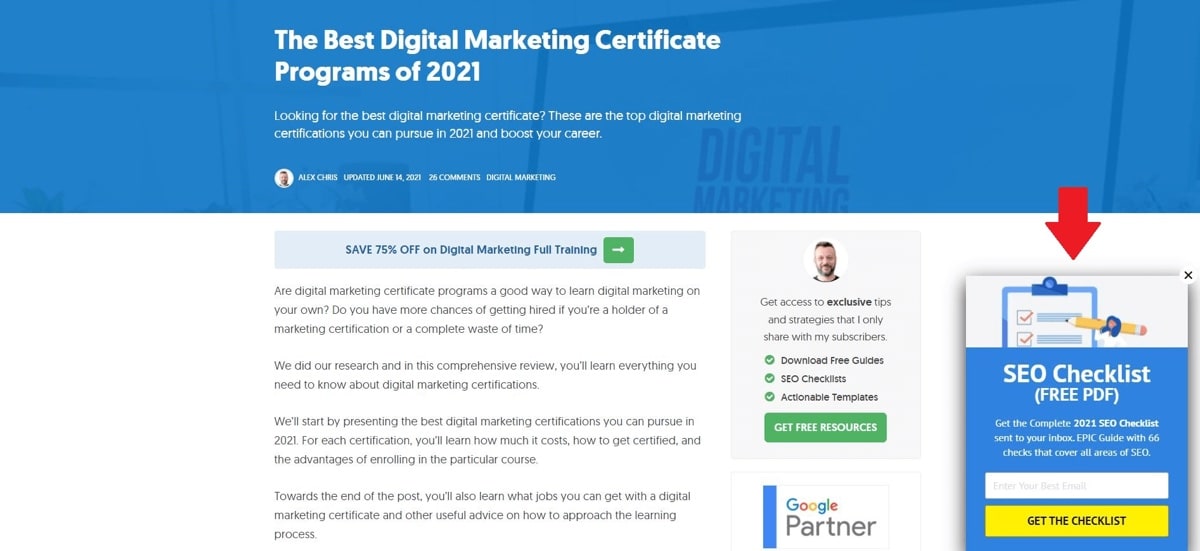
The lead magnet also appears in an exit-intent popup, along with access to other resources. The flyover only shows when a user moves their mouse to close their web browser.
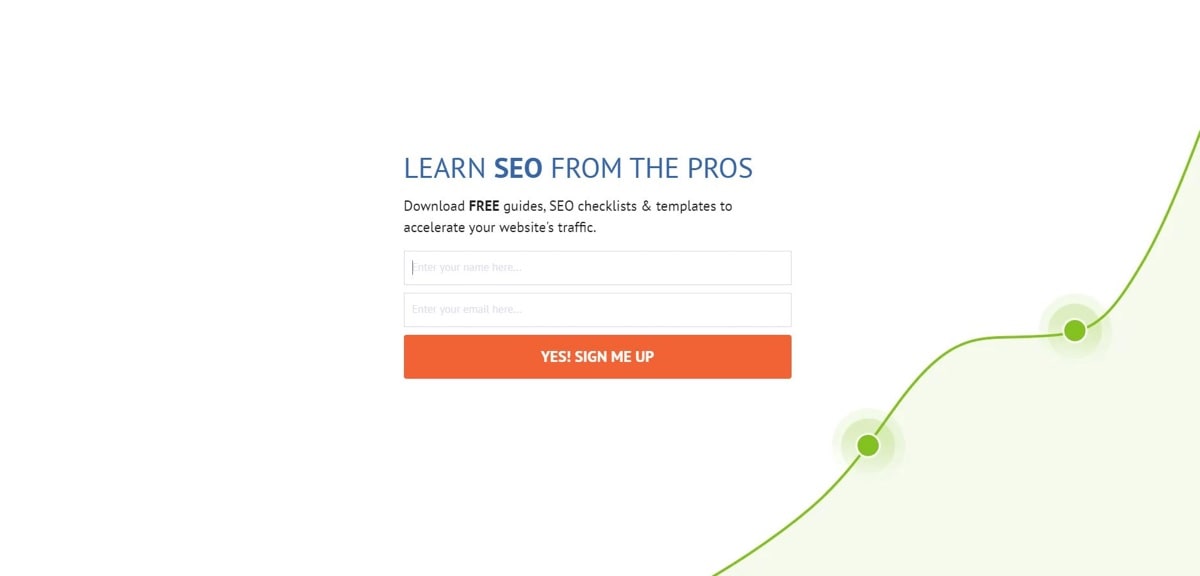
After entering an email address, users receive a confirmation email needed to verify their subscription.
Once you confirm your subscription, you are taken to a resource page where you can download the checklist along with other useful material.
You’ll also receive a follow-up welcome email that includes a special offer for our Digital Marketing Course bundle.
2. GetResponse Free Trial
GetResponse is an email marketing software that allows users to manage their email lists and create automated email campaigns.
They offer users a 30-day free trial to test-run the platform and all its features. It is an enticing offer as users do not need to provide their credit card information when signing up.
If you end up deciding that you do not want to continue using the platform, you won’t need to worry about canceling your subscription.
GetResponse uses its homepage as a landing page, presenting the lead magnet and its CTA above the fold.
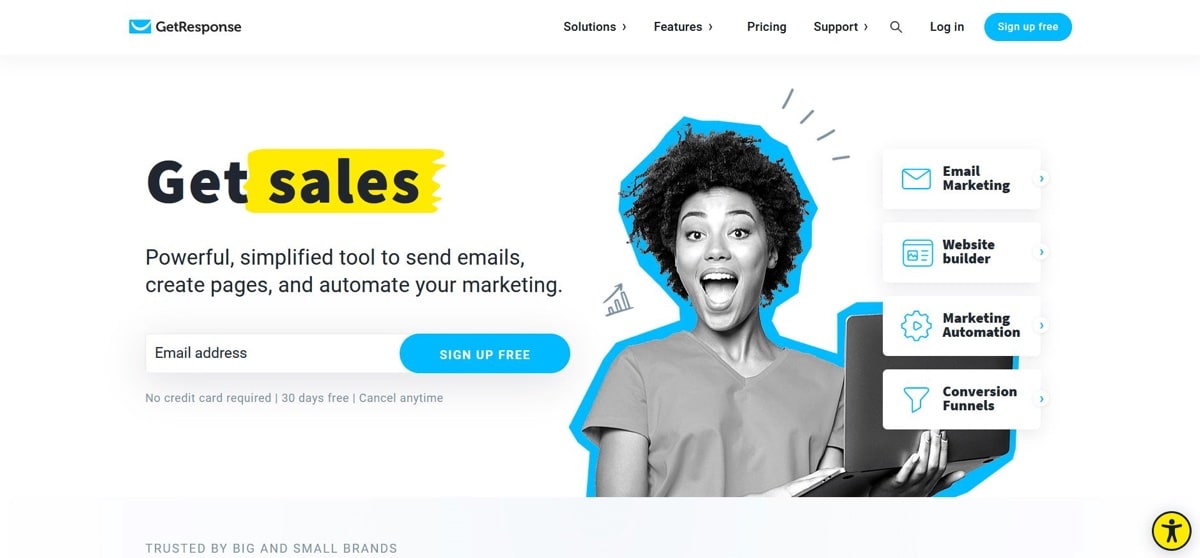
To gain access, you must first submit your email address. You are then directed to a page where you need to enter your name and create a password.
After you provide this info, you’ll receive a confirmation email to activate your account.
Once you do, you immediately have complete access to the platform for 30 days.
3. HubSpot PPC Kit
HubSpot is a SaaS provider with various software tools including a CRM, email autoresponder, content management system (CMS), and more.
The company is well known for its lead magnets. In fact, they have over 100 of them, each targeting a specific interest area. A list of all the lead magnets is available on their resources page.
Each lead magnet has its own dedicated landing page. They are also featured on relevant blog posts.
One great example is their PPC Management Template which is featured on their “how to manage a PPC campaign” blog post.
Users can go to download the template from a CTA button at the top of the page as well as a slide-in form in the right corner of the screen.
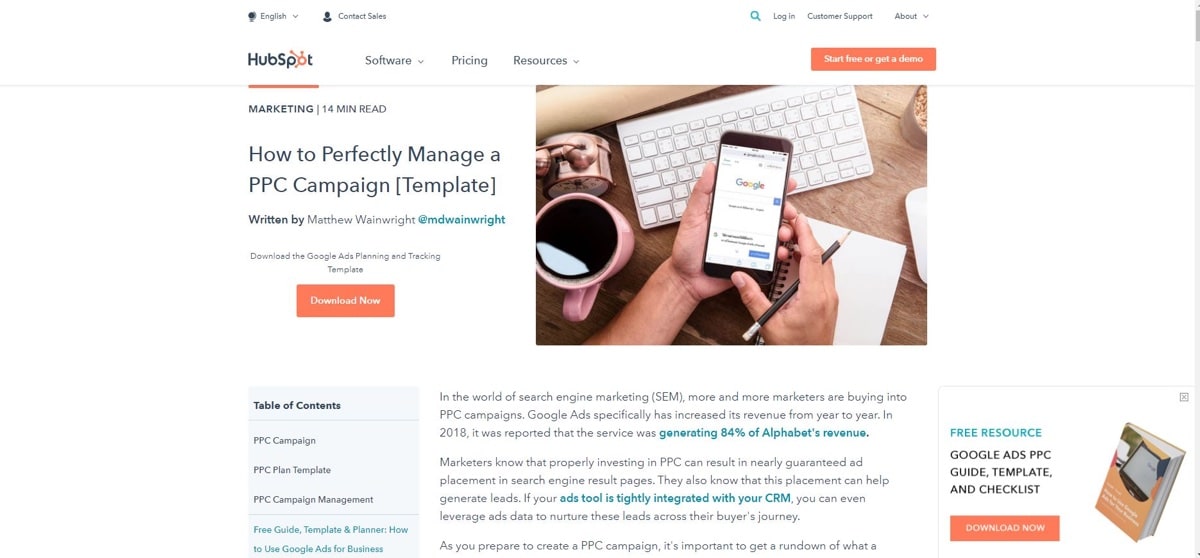
When you click the CTA button you go to the dedicated landing page for the lead magnet.
The landing page explains the offer in more detail, making it clear what value users will receive for subscribing.
The submission form only includes a field for your email address. After you enter your email, you land on a thank you page with a link to download the template.
The contents include a spreadsheet, a PDF checklist, and a guide on how to use Google Ads.
4. OptinMonster Case Study
OptinMonster is a software solution that helps website owners grow their email lists. Users can create pop-ups, contact forms, gamified wheels, and more.
Naturally, OptinMonster understands the lead generation process and the importance of creating high-quality lead magnets.
One example of a lead magnet they use to grow their prospect list is a case study on how Social Media Examiner used their software to gain 250,000 email subscribers.
OptinMonster uses an exit-intent popup to display the lead magnet to users on different pages across their site. When a user goes to leave the site, the popup appears.
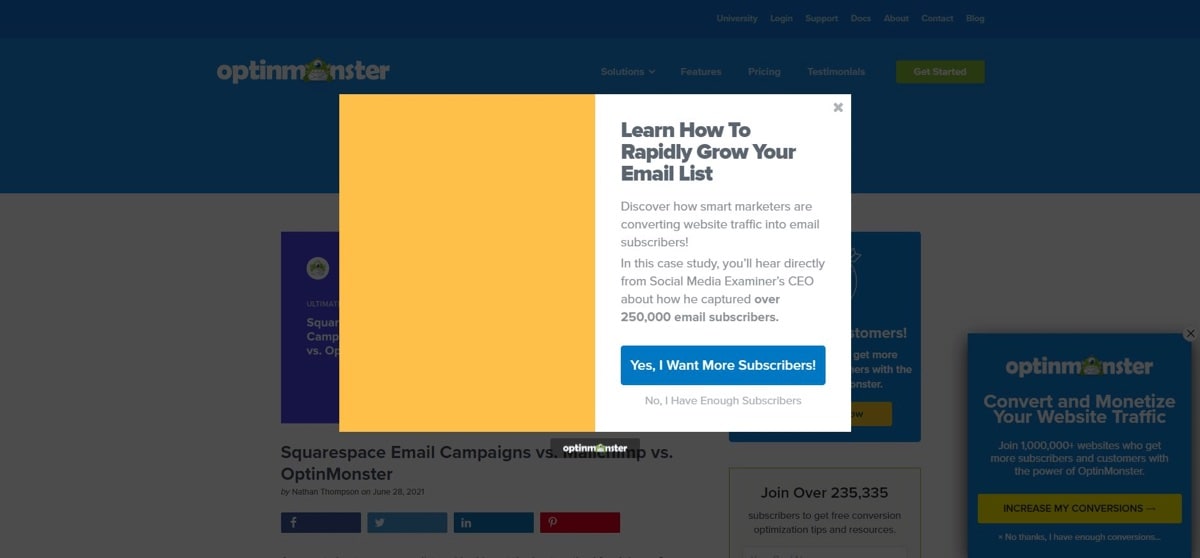
When you click the CTA, the form prompts you to provide your email address and name. Once you do, you’ll immediately see a button to download the case study.
You’ll also receive a welcome email with a link to the file.
5. Skullcandy Free Discount
Skullcandy is an electronics brand specializing in earphones and other audio equipment.
Their e-commerce site uses a free discount for first-time buyers as a lead magnet. Users must agree to subscribe for emails and texts.
It’s unique in terms of e-commerce lead magnets as the phone number is required.
Soon after landing on the homepage, a modal popup appears. It includes details for the offer along with a field for your email address.
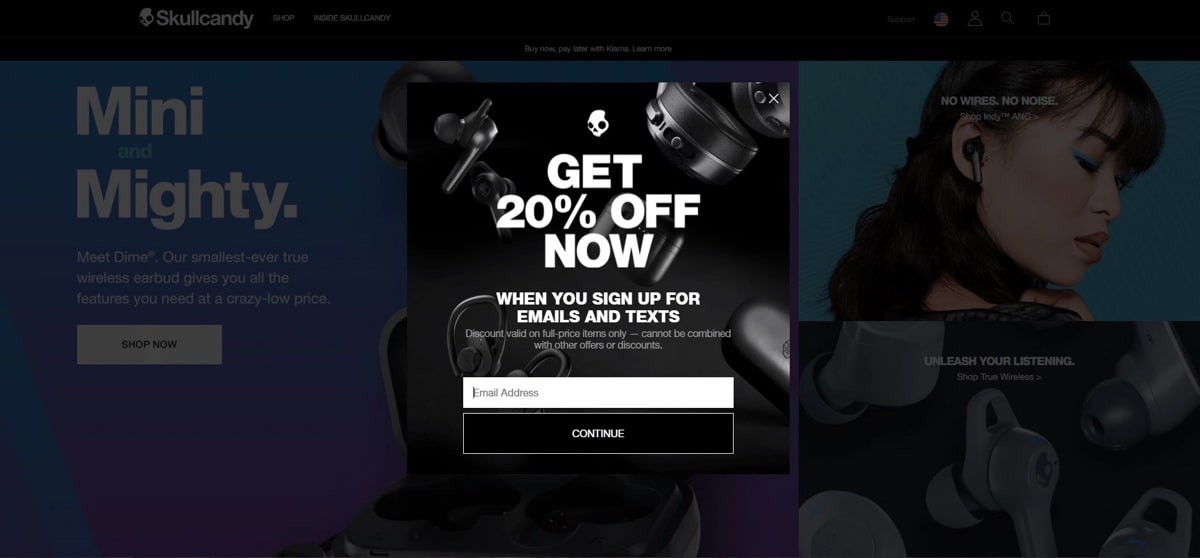
After you enter your email address, you are asked to provide your phone number.
Once you do, you receive a confirmation text message. Responding with a “Y” confirms your subscription. You’ll then receive a message with a link to your discount code.
Key Learnings
Lead magnets are a key component in the process of turning visitors into customers. They allow you to collect valuable contact information that you can use to communicate with your audience directly.
With a lead magnet, you can provide value to your users while establishing yourself as a thought leader in your industry.
When these leads look to solve their pain points, they’ll immediately think of your business.
The best part is, lead magnets are easy to create.
Try building one of the lead magnets we’ve discussed and see how it can help your business.

